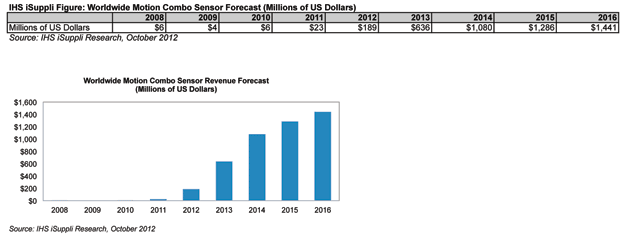Tablets and Smartphones Drive 700 Percent Surge in Motion Combo Sensor Market in 2012
El Segundo, Calif. (Oct. 8, 2012)—Spurred by rapid adoption in cellphones and media tablets, the market for combo motion sensors will surge by more than 700 percent at the end of 2012, according to an IHS iSuppli Microelectromechanical Systems (MEMS) Market Brief from information and analytics provider IHS (NYSE: IHS).
Revenue for combo motion sensors will rise to $189.1 million in 2012, up from just $23.0 million in 2011. Although combo sensors have been around for four years, revenue during the first three years was negligible because of the paucity of product offerings, with the sector beginning to take off only in 2011.
Growth starting this year, however, will be phenomenal. Aside from the explosive year-end upsurge, another hefty increase—equivalent to 236 percent—is projected for 2013, when revenue hits $635.6 million.
The market then crosses the billion-dollar mark the following year in 2014.
By 2016, combo sensor revenue will amount to $1.4 billion, as shown in the figure below, accounting for 71 percent of the overall motion sensor space in consumer and mobile applications. Discrete accelerometers, gyroscopes and compasses will make up the remainder of the market, or 29 percent, based on 2016 revenue of $561.9 million, in view of steadily shrinking usage.

“Motion sensors—including gyroscopes, accelerometers and compasses—have become ubiquitous in smartphones and tablets,” said Jérémie Bouchaud, director and principal analyst for MEMS and sensors at IHS. “Since these sensors work together and their signal must be fused, combo sensors not only save space, they are also easing implementation by offering a convenient plug-and-play integrated solution.”
Axis powers
Combo sensors represent a useful way to save space by integrating more functionality into a single package. Various configurations exist—such as 9DOF (degree of freedom) units made up of a 3-axis accelerometer, 3-axis gyroscope and 3-axis electronic compass; 6-axis compasses that include a 3-axis accelerometer and 3-axis compass; and 6-axis IMUs (inertial measurement units) comprising a 3-axis accelerometer and 3-axis gyroscope.
The hefty growth this year is due to increased use of combo sensors in both cellphones and tablets.
Dissections conducted by the IHS iSuppli Teardown Analysis Service confirm that 6DOF combo sensors are present in such recently released mobile devices like the Asus Nexus 7 tablet; the Samsung Galaxy Note 10.1 tablet and the Samsung Galaxy S III smartphone.
In comparison, the Apple iPhone has a discrete motion sensor solution for its best-selling phone, doing so in order to retain flexibility and implement custom parts if needed.
Combo sensor configurations gain momentum
Among combo sensor configurations, the 6-axis IMU will be dominant. According to California-based InvenSense, the majority of its handset and tablet customers have converted—or are in the process of converting—to a 6-axis solution, which offers superior functionalities over a 3-axis design.
Another configuration, the 6-axis compass, features improvements such as a reduction in size, which provides more flexibility in the placement of the module while mitigating electromagnetic interference.
The new generation of smaller, more competitive modules is made by Bosch of Germany, Aichi Steel of Japan, and more recently, U.S.-based Freescale Semiconductor and Italian-French entity STMicroelectronics.
A third device, the 9DOF or 9-axis IMU, is also gaining traction among manufacturers, following introduction in the last few months by InvenSense and STMicroelectronics of their respective products. The 4 x 4-millimeter form factor is attractive, and both handset and tablet manufacturers are now pressing sensor makers to ramp up production. Handsets and tablets featuring 9-axis IMUs will make their first appearance in retail by the first quarter of 2013, IHS believes.
Manufacturers join the combo sensor race
For 6-axis IMUs, STMicroelectronics and InvenSense enjoy a considerable head start after initial efforts, launched long before other players made their move, are now paying off. Nonetheless, Bosch and New York based Kionix will join the fray, and the two companies should be in serial production before the year ends. Other suppliers likely to enter the race soon are Fairchild Semiconductor and Maxim Integrated Products, both from San Jose, Calif.
In 9-axis IMUs, STMicroelectronics and InvenSense are the first to go into production. Bosch, however, is also well-positioned to compete in the segment, being the only company with in-house technologies for all three sensors comprising accelerometers, gyroscopes and compasses.
In the 6-axis compass area, STMicroelectronics took the lead in 2011—even though Bosch is rapidly winning market share because of a small and very competitive module. Freescale may also become a strong participant given its unique magnetometer technology for compasses.
Overall, MEMS suppliers are now starting to take the lead in integrating magnetometers into their combo sensor packages—whereas compass manufacturers historically had directed the way in the past.
While accelerometer suppliers have generally been in a position to develop a gyroscope—and vice versa—the manufacturing process for the compass is usually radically different from the process for MEMS accelerometers and gyroscopes, causing a gap in integration efforts between magnetometers and MEMS technology.
This means magnetometer suppliers and MEMS companies must continue to cooperate in order to strengthen 6-axis compass solutions or enhance the compass component in 9-axis IMUs.
■
Advertisement
Learn more about IHS iSuppli





